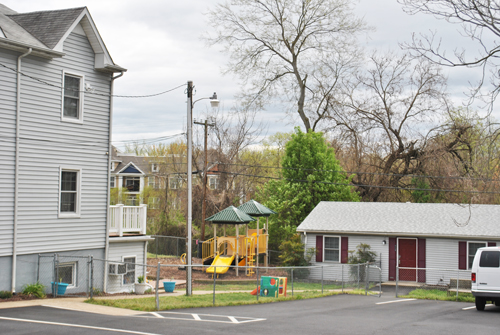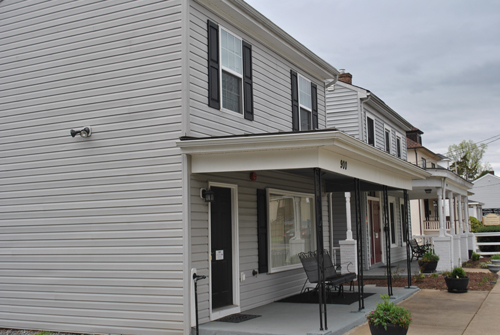



Charles Sydnor, the rector at the time, fondly remembers the beginnings of Hope House:
“In 1985 the plight of the homeless was not well known to many of us. So on a cold February morning when our little Brotherhood of St. Andrew Chapter met at 7 A. M., we found a homeless man trying to play the piano in Faulkner Hall but still a little drunk. He had spent the night in the entrance foyer which was there before remodeling. We listened to Roger’s story of being a Vietnam Vet who had lost his way and stories about others on the street.
“Later the Virginia Episcopalian did a story about Roger our drunken angel who brought us the message of the plight of the homeless. We also invited a local resident who took homeless persons into her private home as her ministry to share with us and learned much more.
“Our group said someone should do something about this and I said why not the five of us? So using the few bucks we had from our weekly coffee can donations, we took out an ad inviting anyone concerned about homelessness in our area to a meeting here and about 70 people came.”
This was the beginning of an additional direction for St. George’s – that shelter for the homeless was part of our mission and ministry. The purpose was to establish a temporary shelter for the homeless.
A property was found. On Sept 8,1985, the Vestry appointed a 3 Vestry member to investigate the purchase of 902 Lafayette. The committee was composed of Thurman Brisben, Bill Greenup and Sam Mason. A special Vestry meeting was held on Sept 21 and the decision was that a repayment plan to begin 1 year from the date of settlement.
There would be two congregational meetings – One in Oct., 1985 to approve the concept and a purchase price. The motion said church would purchase property as a “temporary shelter and other support services to homeless persons, particularly families who are permanent residents.” The price was $75,000. The church would borrow $67,500 on a 30 year mortgage at a 12% rate. The church would make the down payment.
The latter would come from the sale of the Cornell Street rectory. In January, 1985 the church had sold the Cornell street rectory for $10,000 down payment in CDs, $90,000 first trust. These funds were housed in the Rectory Fund which would support the property’s mortgage as well as real estate taxes and insurance. As part of the deal an interest income account from the CDS would be available for specific projects.
The entity would cover all of their expenses and title would remain with St. George’s until they purchased the entity from the church. The proposal carried but there was some opposition. Some were concerned about the financial support of that entity in the meeting. However, others countered withthe notion of “Christian brotherhood, helping others, and fulfilling mission. The motion passed 64-5.
A second meeting was held to approve the details of the mortgage. The details would be worked on by a committee of Bill Greenup, Sam Mason, Fritz Leedy, Ted Barrow, and Charles Sydnor. The second congregational meeting, Jan. 26, 1986 approved a mortgage with Fredericksburg Savings and Loan at 9.5% on a motion by Bill Greenup.
Renovation began in early 1986 with many volunteers and contributions from the community. During 1986, the shelter was named “Hope House” at the suggestion of the Charles Sydnor.
The shelter opened in January, 1987 in the middle of a snow storm with an initial capacity of 14 person. That first year ending January, 1988 they housed 160 people and had come in contact with 820 others. The facility was usually filled to capacity.
In that same year they converted a cottage in the property into an annex with 10 more beds with help from a $25K matching grant from state. In 1988, St. George’s won the community service award, first time a church received this honor
The church would support Hope House through frequent donations of the Advent and Easter offerings. In 1988, A ECW Fall auction raised approximately $6,700 which was split between Rappahannock Adult Activities, the Food Relief Clearinghouse and Hope House. Frequent articles in the newsletter collected household articles for Hope House
A day program was planned in 1988 to teach skills to residents through coordinator and St. Georgian Sherry Owens. The skills would include those involved in job interview, tenant/landlord relations, household (cooking, sewing), furniture refinish ,child care, literacy, child development techniques and household budgeting
Hope House began making $100 payments back to St. George’s in 1988. The Vestry decided to give half of these payments to Christ Church for a building program and the other half to the Diocese.
Helping out the process, the Fredericksburg Area Association of Realtors raffled a house in 1988 and netted more than $50,000. The mortgage was reduced from $66,085 at the end of 1988 to only 10,734.38 by the end of 1989.
What would happen to residents when they left Hope House ? In 1989, Fritz Leedy led an effort to create a revolving fund for families exiting from Hope house to help them make a security deposit on a new property and to pay the first month’s rent. The records are not clear on how many were helped – one case providing $650 was documented as well as that person beginning the repayment of the funds
George Van Sant in 1989 led an effort from the Vestry to negotiate a sales agreement with Hope House which the Vestry authorized. The price would be fixed at the total cost to the church. Hope House would pick up the insurance and tax payments. The price was $97,500 with a credit of $40,000 for a total purchase price of $57,568 which would be financed by St. George’s. Hope House would continue to pay a monthly rent monthly quarterly or annually. If the amount of interest St. George’s was paying was greater than Hope House pays, then that difference would be added to the principal.
In 1990, St. George’s won a $3,000 grant from the Diocesan Fund For Human Need for a Children’s Support Project at Hope House
By the end of 1992, the Hope House mortgage was paid in full. St. George’s would continue to support Hope House through yearly donations through 2015. In 2002 and 2004 St. George’s contributed to a Summer preschool camp for Hope House children
Despite the success of Hope House, a number in St. George’s realized that that the problem of homelessness was larger than one entity. Hope House was for permanent residents. What about the others in Fredericksburg not helped by Hope House ?
